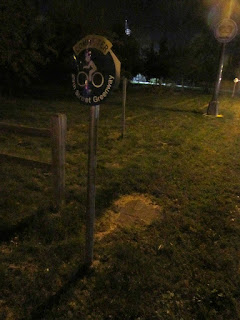Minneapolis trails such as the Midtown Greenway and the Dinkytown Trail often have stop signs at intersections, exits, and entrances. This is well and good -- we'll have fewer crashes if everybody knows who gets to go and who must give way. Many of
these stop signs are only 12 inches (or less!) edge-to-edge, yet the standard,
the Manual on Uniform Traffic Control Devices, requires a size
of 36 or 30 or 18 inches on a shared-use path stop sign. (Ref:
http://mutcd.fhwa.dot.gov/htm/2009/part9/part9b.htm
). A sign that's 12 inches edge-to-edge is about half the area of one that's 18 inches. So what? These tiny signs can be easily overlooked, especially at night.
A Minnesota appeals court in an unpublished opinion held
that non-standard regulatory signs are not enforceable. Other courts do not have
to consider unpublished appeals opinions as precedent, yet most probably
will be swayed by the appellate judges arguments.
Further, the standard requires that stop signs not have other signs mounted to the back. This is so other driver can see who's got the stop sign and, therefore, who's got the right of way. Yet often there are signs mounted to the back of stop signs on trails.
The front of a stop sign on the Greenway:
The same sign from the perspective of crossing traffic:
A front shot of a different Greenway sign with an obscured backside:
The backside of the previous sign:
They don't obscure the backs of stop signs on streets:
Why is Minneapolis using these hard-to-see non-standard stop signs?
Manual on Uniform Traffic Control Devices:
Section 2B.10 STOP Sign or YIELD Sign Placement
04 No items other than inventory stickers, sign installation dates, and bar codes shall be affixed to the fronts of STOP or YIELD signs, and the placement of these items shall be in the border of the sign.
05 No items other than official traffic control signs, inventory stickers, sign installation dates, anti-vandalism stickers, and bar codes shall be mounted on the backs of STOP or YIELD signs.
06 No items other than retroreflective strips (see Section 2A.21) or official traffic control signs shall be mounted on the fronts or backs of STOP or YIELD signs supports.
08 A sign that is mounted back-to-back with a STOP or YIELD sign should stay within the edges of the STOP or YIELD sign. If necessary, the size of the STOP or YIELD sign should be increased so that any other sign installed back-to-back with a STOP or YIELD sign remains within the edges of the STOP or YIELD sign.









